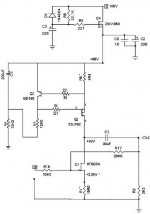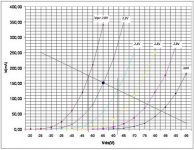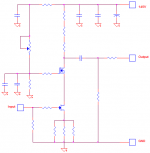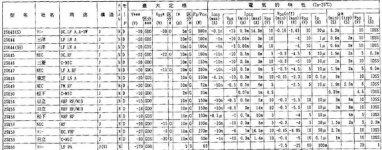I have tried this schematic (a combination of components of various ZENs) as a preamp for Zen9 and got an unexpected good and powerful sound. The jFET is a russian vertical SIT transistor KP926A with the triode-like output characteristics. Quiescent current is 150 mA, what seems to be crazy for a preamp. Undistorted sinusuidal output voltage is up to 27V, that is good for a power follower.
Attachments
Yep, SIT or V-FET: JFET with a gridlike gate buried inside the
channel... Acts like a vacuum triode, it has an intrisic space
charge (or carrier gradient) feedback we know as "Mu".
All the Japanese V-FETs dried up and dissapeared long ago,
is this Russian version an available component, or rare???
Such feedback doesn't have to be intrinsic. O.H.Schade of
RCA proved that long ago, transforming a set of Pentode
curves into a Triode with feedback (not simply strapping
the screen to the plate.) Nelson's Zen a modern example.
But intrisic feedback from the space charge is awful quick
way to stabilize voltage linearity, where you want minimum
phase shift in your local feedback loop. It should be faster
than any feedback path taken through external resistors.
Mu of an input device inherits to the output in a Darlington
or Sziklai arrangement. So you can abuse a small signal SIT,
or Triode, and scale up the output current by the Beta of an
ordinary BJT. Mu linearizes voltage gain for both, if anodes
are wired directly together. But from the BJT's perspective,
this is an external feedback path, not an intrisic one.
channel... Acts like a vacuum triode, it has an intrisic space
charge (or carrier gradient) feedback we know as "Mu".
All the Japanese V-FETs dried up and dissapeared long ago,
is this Russian version an available component, or rare???
Such feedback doesn't have to be intrinsic. O.H.Schade of
RCA proved that long ago, transforming a set of Pentode
curves into a Triode with feedback (not simply strapping
the screen to the plate.) Nelson's Zen a modern example.
But intrisic feedback from the space charge is awful quick
way to stabilize voltage linearity, where you want minimum
phase shift in your local feedback loop. It should be faster
than any feedback path taken through external resistors.
Mu of an input device inherits to the output in a Darlington
or Sziklai arrangement. So you can abuse a small signal SIT,
or Triode, and scale up the output current by the Beta of an
ordinary BJT. Mu linearizes voltage gain for both, if anodes
are wired directly together. But from the BJT's perspective,
this is an external feedback path, not an intrisic one.
flg said:Yep, my circuit does similar things. I just refer to it as a VAS...
I guess the powerful and rich sound from the schematics in post #1 arise due to the triod-like characteristics of the single amplifying device.
I also tried to make the schematics more fast by employing casode - between the source of KP926A and the ground I inserted smaller jFET (not SIT) and made adjustments at 100 mA current. Due to decreased input capacitance of modified circuit it became very fast, it started to reproduce square wave up to 1 MHz, and I was close to heaven thinking I got something extraordinary. But during listening I have got ordinary sound, similar to what i have with my good preamp Parasound JC2. Cascode did not allow the triod-like features to operate. My current conclusion: the single-stage amps like some Zen versions benefit strongly from special preamplification stage; amplifier-speaker interaction is more important than good measurements with resistive load.
bigwill said:Wow, there are solid state devices with curves like that?
These transistors are in TO-3 case and were originally designed for power electronics, still available in Moscow for 7-8 USD. Their drawback is large spread of initial currents at Vgs=0, so matching of pairs is difficult. Another drawback is that input capacitance is not specified by manufacturer, I guess it could be similar to or even larger than that of LU1014.
kenpeter said:Yep, SIT or V-FET: JFET with a gridlike gate buried inside the
channel... Acts like a vacuum triode, it has an intrisic space
charge (or carrier gradient) feedback we know as "Mu".
All the Japanese V-FETs dried up and dissapeared long ago,
is this Russian version an available component, or rare??? ...
These KP926A stiil available, and moscow designer Konstantin Musatoff offers two model of power amps based on KP926A in output stage, with output transformer. These transistors fit well many tube schematics and can be loaded with 300V at 150mA.
Good luck with your circuit. Feed that into a single-ended buffer and make happy music!
Nice device characteristics. Are there any devices with similar characteristics available in Europe?
VladimirK said:Enclose measurements for KP926A
Nice device characteristics. Are there any devices with similar characteristics available in Europe?
Gordy said:... Nice device characteristics. Are there any devices with similar characteristics available in Europe?
I afraid V-FETs were not produced in Europe. But due to some reason (I do not understand this, since MOSFETs are much better for power electronics) KP926A are still produces in Novosibirsk in Russia in smaller metal-plastic case.
Enclosed is a datasheet for KP926A at manufacturer's site. Unfortunately, the site and datasheet are in russian only.
http://ru.nevz.ru/downloads/fpdf/PP/tranzistor.pdf
http://ru.nevz.ru/downloads/fpdf/PP/tranzistor.pdf
In the neighbour thread "Solid State Tube?" there is an info how to buy 2SK60 (vFETs from SONY).
They have only 190pF input capacitance. Would be interesting if somebody measure and report output characteristics Id vs Vds. Unclear only their maximum drain-to-source voltage.
They have only 190pF input capacitance. Would be interesting if somebody measure and report output characteristics Id vs Vds. Unclear only their maximum drain-to-source voltage.
Attachments
Why do we distinguish the triode-like characteristics and which "ghost" is hidden behind the "triodicity"? I see only two things: 1) lower output differential resistance and, hence, better match to next stage, including reactive components of the next stage input impedance; 2) if we speak about tubes, they do not have so called thermal distortions (on contrary to semiconductors). In case of the KP926A, we can decrease thermal distortions by taking high rail voltage and class A operation. By this we diminish dissipated power deviations from average value. Are there additional important points?
VladimirK said:Why do we distinguish the triode-like characteristics and which "ghost" is hidden behind the "triodicity"? I see only two things: 1) lower output differential resistance and, hence, better match to next stage, including reactive components of the next stage input impedance; 2) if we speak about tubes, they do not have so called thermal distortions (on contrary to semiconductors). In case of the KP926A, we can decrease thermal distortions by taking high rail voltage and class A operation. By this we diminish dissipated power deviations from average value. Are there additional important points?
You can use it as a source follower; in such case you can use one more source follower to bootstrap it, and counter-modulated CCS to load it. I minimize thermal effects such a way, also capacitances' and transconductance variations are minimized.
VladimirK said:Enclosed is a datasheet for KP926A at manufacturer's site. Unfortunately, the site and datasheet are in russian only.
http://ru.nevz.ru/downloads/fpdf/PP/tranzistor.pdf
Thank you! I was looking for their phone numbers.
Speaking of specs, they don't guarantee clean crystals, so gate current specified is huge. Also, no capacitances specified.
VladimirK said:
Why do we distinguish the triode-like characteristics...
I know almost nothing about semi-conductors, so I talk from the perspective of vacuum tubes: the measurements for KP926A look like a triode and suggest a very good linear amplifier when using... -2.4 V bias, 63 Vds, 150 mA constant current. But also the advantages of...
No high voltage power supply
No heater power supply
No socket
No hot glass parts
No feedback
If that were a triode I would use it open loop, and (subjective) experience suggests this type of characteristic is 'good' for human hearing response.
- Home
- Source & Line
- Analog Line Level
- "Crazy" power for preamp



